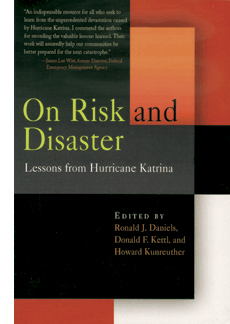Rapid Response: Conference and Book Address Preparing for the Next Katrina

When 91,000 tons of ice intended for Hurricane Katrina relief took a road-trip around the country, many considered it a tragicomic example of the bungled governmental response to the disaster.
“On the other hand, Wal-Mart did a stunning job of getting a lot of stores back open again” in the flooded Gulf region, observes Dr. Donald Kettl, the Stanley I. Sheerr Endowed Term Professor in the Social Sciences and director of the Fels Institute of Government. “They’re superb at logistics management. It’s clear that FEMA is not.” It’s therefore worth asking whether the agency should rely on private companies for help with such tasks during a future disaster.
This was one of many questions posed during a risk and disaster conference organized by Penn in Washington on December 1 and in a companion book published by the Penn Press just a month later. On Risk and Disaster: Lessons from Hurricane Katrina was produced using the technology of “on-demand” publishing, which allowed the press to make it available “in a matter of weeks, rather than the several months books typically take in the publication process,” according to Eric Halpern, director of the press.
The project was the brainchild of Penn Provost Ronald Daniels [“Gazetteer,” July/August]. After the disaster he met with school deans, and then faculty from across the University, to explore the idea of convening “some of the best minds on campus and beyond to address some of the policy and institutional and moral issues that resulted from Katrina and to engage public decision-makers.”
Kettl served as one of the conference’s co-organizers along with Dr. Howard Kunreuther, codirector of the Risk Management and Decision Processes Center at the Wharton School [“Insuring Against Terror,” July/August 2005], Provost Daniels, and the executive director of his office, Lois Chiang.
Kettl, Kunreuther, and Daniels also co-edited the resulting book, which featured sections on “The Challenge of the Gulf,” “Thinking About Risk,” “Private Sector Strategies for Managing Risk,” and “The Government’s Role in Disaster Preparedness and Response.”
“There was an overwhelming enthusiasm for embarking on the project,” Daniels says. “It was very heartening for me as the new provost to be able to come into a new community where there was a firm determination to bring ideas to bear on such a difficult set of issues in such a timely and responsive way.” The conference drew 250 participants from the academic, public, and private sectors.
To Kunreuther, a timely analysis of Hurricane Katrina is critical: “If we don’t take advantage of the situation now, things will probably go back to normal, and people will not take [protective] steps in advance of another disaster,” he says. As the Gazette was going to press, the Penn Urban Research Institute held a second conference on campus to focus on rebuilding the Gulf Coast. Those findings, too, will be collected in another “instant” book, due out in February.
Kunreuther’s book chapter in Risk and Disaster considers the role insurance can play in disaster planning. “We don’t think anyone was fully aware of how serious the problem was,” he says. “In fact, areas that should have been classified as flood prone were not, so people [living there] could not even buy flood insurance,” which is offered through a national program in plans separate from private policies that cover other kinds of property damage.
He argues that the time might be right for creating comprehensive disaster insurance to cover all hazards. In addition to giving property owners full protection, it would spread the flood risk across a whole set of hazards, making it easier to insure.
“A comprehensive program is a great idea, but it’s got to be based on rates that reflect the risk of people living in an area,” Kunreuther adds. “Give them the knowledge to take steps [either to protect their home from damage and receive a lower premium] or to decide they don’t want to live there. Low-income people may need to be helped out in some way, but that’s a subsidy issue, not an insurance issue.” Rather than forcing homeowners to pay up front the cost of safeguarding their properties from storms, Kunreuther suggests, payments could be tied to their mortgages and spread out over many years.
People versus place was another of “the critical issues that percolated through the [Washington] conference,” according to Daniels, who co-wrote a chapter in the book with University of Toronto law professor Michael Trebilcock about what socially responsible and cost-effective government interventions in flood-prone areas like New Orleans might look like.
“Some [at the conference] felt that New Orleans, because of its history and its role in the Gulf region, should be rebuilt almost at any cost, whereas there were others who felt that this is a city in a region that even prior to Katrina faced significant economic challenges,” and it would be better to help people “migrate to other communities and start life anew.”
The question of who does what in a disaster was addressed in a chapter co-authored by Kettl and Governing magazine writer Jonathan Walters. “You have a major storm that pays no attention whatsoever to the boundaries—between states, between state and local governments, and the government and private sector. You just have a big mess that demands a public response,” he says. “We learned how important it is to build far more robust collaborations.
“We need to get a lot smarter and faster and figure out how to deal with these issues,” Kettl adds. “We need to be prepared when the next inevitable crisis comes along.”
—S.F.




